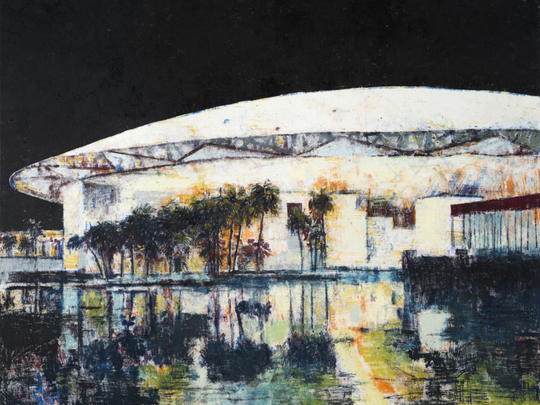
Leila Heller Gallery is hosting two exhibitions of new works by American artists Jacob Hashimoto and Enoc Perez. While Hashimoto has used traditional craft materials and techniques to represent our contemporary technology driven dystopian world, Perez has turned to classical painting to explore the expression of utopian ideals in the architecture of this region.
Hashimoto uses traditional Japanese kitemaking techniques to create kite-like discs from rice paper and bamboo that he then links together with strings and arranges in layers to construct complex compositions. The centrepiece of his first show in the UAE, The Eclipse, is a monumental installation that looks like a huge black cloud spreading across the ceiling of the gallery.
The billowing form is made up of more than 8000 black kite-like discs suspended from the ceiling, surrounded by hundreds of white discs. Barely perceptible stars are screen printed in ink on many of the black discs.
The work is a site-specific iteration of an installation the artist presented earlier this year at the Palazzo Flangini for the 57th Venice Biennale as part of an exhibition titled The End of Utopia. In this new version the black cloud is shaped like the map of the US with the stars alluding to the star-spangled banner.
The immersive installation comments on the current political situation in the US and its impact across the world. It also speaks about the structures and systems that were supposed to lead us to utopia, but have instead become the cause of a dystopian world plagued by political, social, economic, technological, and ecological imbalances. Perhaps the barely visible stars also allude to celestial realms that transcend these issues, offering a glimmer of hope for a future where we see and do things differently.
Hashimoto is also presenting a series of smaller works that echo the same themes. Unlike the monochromatic centerpiece, in these works he has decorated the discs with paintings and collages in vivid colours. The patterns and motifs reference natural landscapes, cosmic vistas, video games, sci-fi films, electronic circuits, art history and traditional weaves, reflecting the real and virtual world and conveying a sense of the endless stream of imagery available on the screens of our gadgets.
In each work, strings of these discs are arranged in multiple layers between wooden frames, representing pixilated images, digital networks, as well as the layers of memory. By thus blending traditional handcraft and elements from nature with modern digital technology and imagery, the artist links the past with the present and the future.
He maps journeys and timelines as mankind moves along a path of technological advancement that is alienating us from nature, destroying our environment, and blurring the boundaries between the real and virtual world.
Perez deals with solid built structures in the urban environment, but infuses them with a dream like quality. The artist was born in Puerto Rico and moved to New York in 1986. He is best known for his paintings of modernist buildings that nostalgically capture the utopian ambitions and optimism which inspired their construction.
“In a way, these architects really believed in the idea of utopia. There is a true sense of believing in these buildings, which you do not see in contemporary architecture. The fact that they are from a different era makes them nostalgic. In a world where artists are experimenting with new printing technologies and digital art, I love painting and believe in it, and that is what I share with these architects who believed in utopia,” he says.
His show, The Desert Bloom, features romantic portraits of iconic buildings in the region such as the Sheikh Zayed Mosque in Abu Dhabi, the futuristic Haydar Aliyev Cultural Centre in Baku designed by Zaha Hadid, and the ancient and revered Dome of the Rock in Jerusalem. The paintings are contemplative and emotional. They capture not just the physical contours and external beauty of the structures, but also the soul and spirit of these spaces, subtly conveying their impact on the environment and on the minds and hearts of people.
“The first portrait of a building I painted was the Normandie Hotel in early 2001. It was a coded way to express my desire for a beautiful woman who was married at the time. Today she is my wife and mother of my children. Similarly, my paintings of these iconic buildings reflect the history, ambition and desire of this region, heralding what is to come in the future,” Perez says.
Jyoti Kalsi is an arts-enthusiast based in Dubai.
The Eclipse and The Desert Bloom will run at the Leila Heller Gallery, Alserkal Avenue, Al Quoz, until November 30.













